The Naze Hide - another recollection
Glad to see my mention of the Naze Hide inspired your reminiscences Peter and Graham -
surely both very interesting additions to the Forum archives. I too can offer a further story
inspired by that little shelter.
Many years ago during one bird breeding season, I was conscripted to do a Little Tern
watch along those outer reaches of the Naze and the Hide was my base when this structure
was in its final resting place overlooking the marshland. It was rather a boring six hour stint -
didn't even see one of those so named! Not a soul approached which would have allowed me
to use my authority, perhaps at the very least to gain some satisfaction in being able to shoo
someone off, which I hasten to add, I would have done most courteously of course! However,
the weather was kind and I strolled about with my eyes down in the manner I would have looked
for fossils below the Naze cliffs, doing this in the hope of spotting something to brighten my day.
Gravelly patches are always worth inspection along this coastline - the chance of finding some
ancient artifact for which the place is renowned. Thus I came upon one area, quite close to the
Hide in fact, where in my search I was to be rewarded with several worked flints of Neolithic age.
Amongst these, to my delight, there was a finely fashioned arrowhead, and in addition and to add
to my excitement, to discover one further exceptional example of prehistoric man's patient
handiwork, a four inch long axe or celt. 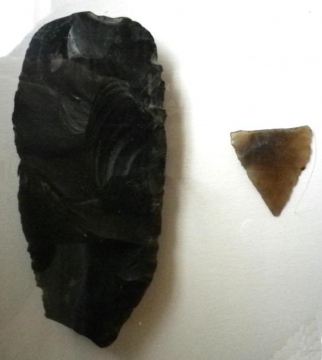
Certainly, that day turned out to become one more pleasant memory of that special seaside-place.
I suppose I have in part to thank the living birds for drawing me to this particular spot, most
times my many visits to the Naze were to be in search of their ancient forebears and for
sure I was royally rewarded in that respect.
When one is a custodian of a scientifically important collection, it becomes an unwritten
requirement of the owner to make the material available for examination by those who can
claim to be seriously interested. In my case, being in possession of a considerable range of
fossils and some minerals, not only from the Naze, or elsewhere in Essex, but from wider
localities around this country, these are then available for inspection. Thus if anyone wishes
to visit us in Holland-on-Sea, then we would naturally need to know in advance to agree the
arrangement, this by simply phoning 01255 814172. re: What has caused this
I imagine anything that goes wrong when the adult insect is emerging and before the elyptra have hardened could cause blemishes and deformed areas on the elyptra. I imagine emergence in cold weather, damp conditions or other particular factors or happenings during this very vulnerable period could easily cause problems. I recently found a large dead Carabus ground beetle with rudimentary elyptral development, where the expansion of the elyptra had clearly not successfully taken place. This was so severe that the insect had failed to survive. Spiders can also fail to extricate themselves from the old exoskeleton at a moult, resulting in death. In these cases humidity certainly sometimes seems to be a factor. What has caused this
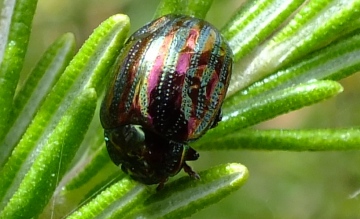 While counting the Rosemary Beetles in our front garden yesterday, we now have 17 on Rosemary and Lavender, I came across the above insect. The elytra were deformed, there appearing to be bubbles in the surface. I had noticed deformed elytra in 2-Spot and Harlequin Ladybirds earlier in the year together with discolouration on Harlequin and 7-Spots. I believe this can be caused when insects emerge in cold weather but can it also be caused by damp conditions ? Thanks for the Memory
Peter/Michael : I too remember the old hide at The Naze and John too of course. Sad he died so young; he was on merchant ships in the war I believe. My first memory of it is very pleasant. I had caught the train from Ingatestone to Walton and walked up to The Naze. Am not sure how old I was at the time - but young! As I walked along the hedgerow path from the tower to the seawall I had wonderful views of a Great Grey Shrike - a new species for me. A few hundred yards further on, along the short path from the seawall to the beach, a second new species appeared - a resplendent Shore Lark. Eventually I made my way to the hide and within minutes was watching a third new species - a Short-eared Owl. Three new birds in one day was exceptional even in those days and I was on cloud nine. Used it many times over the next few years including, on one occasion, during a massive storm. Sitting in a small hut with a tin roof in the middle of the saltings during a thunderstorm was perhaps not the wisest move but I was young then - and immortal! It certainly made for a memorable experience. Shaggy Bracket
There has been a serious shortage of fungi for the last 6 weeks, but the recent rain should mean lots to find in the next few weeks.
Meanwhile, I looked up into our old Bramley tree in our garden this morning and saw a bracket fungus, fairly high up. I used a garden rake, attached to another long pole, to bring it down. It was Inonotus hispidus or Shaggy Bracket. I have mostly seen it on Ash or, rather, on the ground below an Ash, and the only one I can remember seeing alive on a tree was years ago in Epping Forest, where it was at head height on Sorbus torminalis, Wild Service-tree. The books tell me it often grows on garden apple trees too, but I don't often get an opportunity to have a fungus foray in anyone's garden except mine.
But this one is significant on this tree. I don't know for certain when it was planted, but I guess it was around 1932 when the house was built and the garden new. Over the years our tree has provided variable loads of apples and has been host to a wide variety of tiny insects and other invertebrates, nearly all malign. So much so that now, according to my old gardening book, it has nearly all the plagues known to apple trees. A few years ago it was host to a large crop of Armillarea mellea,Honey Fungus, which sprouted next to it, and is a well-known destroyer of trees of many kinds. Now it has Shaggy Bracket as well. It also has very few apples, but nearly all have fallen to the ground due to strong winds recently, even though not yet ripe. I consider this to be its final nail in its coffin. But we won't cut it down yet, as it may host more interesting things before its final demise, and, indeed, after it. It would be nice to have Stag Beetles in my garden, for example, and other fungi. Who knows! Thanks for the memory
Michael, your September Ramble took me striaght down Memory Lane You mentioned the hide on the Naze marshes at Walton and I was priveledged to be one of the group involved in it's construction. It was originally built in the early 1950's on the sand dunes facing the sea. John Weston, after whom the EWT reserve at the Naze is named, was the instigator. Together he and the group collected driftwood, railway sleepers, ships hatch covers, etc, then frequently found on the shore and creeks around the Walton Channel. These were floated to the site via the creeks and sea, group members swimming with them or towing them over the saltings with ropes. The "tin" roofing sheets were taken to the Naze Tower on the roof of Johns van and manhandled with non-salvagable materials and tools out onto the sand bar. Once completed we spent hours out there, weekends and holidays. Spring, Autumn and Winter were for birdwatching, fishing, beachcombing and occasionally night forays with mist nets ringing passing migrants. Summer in the slack period between the breeding of the Little Tern colony, which we used to watch over, and autumn migration, was for swimming and picnics. There was a smal flock of Eider off the hide every summer and we would swim out them, John was a good impersonator of their cooing call and they would swim up to us beak to nose. Unfortunately after a few years errosion took its toll on the sand dunes and the hide was in danger of being washed away. It was dismantled to be reconstructed on the abandonded sea defence wall, where it stood until it's demise. For half a century it had been in the area on the sands and seawall until it was burnt down a short while ago. It had given us much pleasure in the past and shelter to many visitors to the Naze. I remember it with affection in sun, rain, heavy snow, gales,fog, infact anythingthe elements could throw at us. Oh happy days. Slug Bait
Thought you all (!) would like to see this photo, taken by one of the Blue House volunteers, Jennifer Eva, in her garden at Burnham. The cat food was put out for Hedgehogs but they are probably all pot bellied from over indulgence this wet, slug and snail rich summer and the molluscs in this picture were able to enjoy a seemingly carnivorous diet unmolested. Just how much meat is in cat food I wonder?
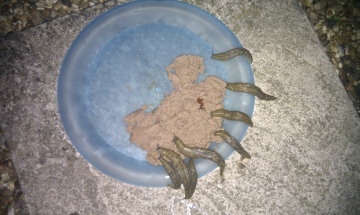
Back from the dead
On the approach to the BWA Hide at Blue House Farm yesterday a Clouded Yellow butterfly was rescued from a spider's web by David Jobbins. The rescue appeared to have come too late as the spider (a Garden Spider type) had already bitten it and it flopped to one side, seemingly lifeless, when placed on the window shelf in the hide. I decided to take it home and take some photographs as I was carrying (as all naturalists do) a selection of pots in my rucksack for just such an eventuality. I left it in the sitting room overnight and returned to it mid-morning today. As I opened the pot it jumped out and began flapping across the carpet as if drunk. It proved to be Colias crocea f. helica, a very pale form (confined to females) which has greenish-white rather than golden yellow upper wings.
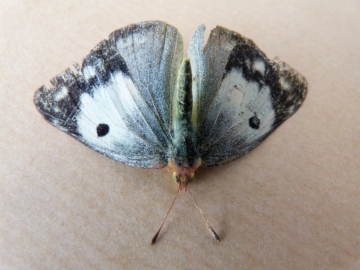
Anyway, I retrieved it and placed it back in the pot, returning mid-afternoon. By this time it had regained a little more co-ordination, appearing to be tipsy rather than blind drunk. As it had not fed for twenty-four hours and I was unsure how long a migrant species like this can survive without refueling I placed it on the Butterfly Bush in the front garden, where a Comma and Red Admiral had been feeding earlier. When last I looked it seemed to be making some attempt to feed and even managed to flutter from one bloom to the next. I suppose that a spider's bite is designed to immobilise rather than kill its prey, so that the body fluids remain exactly that when it comes to dine, but had imagined that even if an insect did manage to escape before the poison worked it would remain permanently paralysed until death intervened, not recover, as this butterfly appeared to do. Perhaps it did not get a full dose.
There have been a few records of this species in the area in recent weeks, at the end of what has been a very disappointing summer for migrant insects. For instance, I have only see a single Painted Lady all year. However, there was a marked influx of Migrant Hawkers during the first week of this month and I recorded over 150 at Blue House on 3rd. Among them was a resplendent male Southern Migrant Hawker (sometimes known as the Blue-eyed Hawker), a species that has begun to colonise southern England in recent years; a not altogether unexpected event, given the change in our climate, as it occurs across much of Europe as far north as the Channel coast. The one pictured below was photographed by Les Steward at Vange Wick. The species has been present here since at least 2010 and is probably breeding, although I'm not sure that has been proven yet. Hadleigh Downs is another good site for it but one or two have been recorded from several other localities as well.
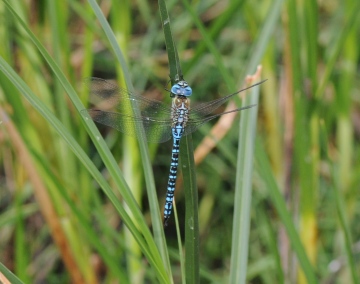
Mary : Other people have commented that there seemed to be lots of Ladybirds in March - when they first emerged from hibernation - but very few since. This may be linked to the lack of aphids in gardens this summer, including my own, where every other pestilence you could imagine has flourished but there has been narry an aphid on the Broad or Runner Beans - or even the roses. The dearth of those ants which depend on honeydew - which has also been remarked upon - may also be connected. As for Codln Moths - you can now buy pheremone traps, which lure the males towards what they hope will be a fruitful liaison but come to a sticky end instead. There is not much clover in my lawn but a sea of yellow Cat's-ear and Autumn Hawkbit on the front lawn - which really impresses the neighbours! The stripped gooseberry bushes I can't help you with. As for craneflies, October is usually the best month but they may be having a bad season like so much else. One year, at Blue House, I estimated that there were at least 20,000 along the route of my weekly butterfly transect and there must have been millions on the reserve as a whole. As each female can lay several hundred eggs the grassland must seethe with leatherjackets, which is probably why the farm supports up to 750 Rooks and 2000 Starlings throughout the winter! Notes from Alan Bunker, Hornchurch
Notes from Alan Bunker, who lives in Hornchurch, from an email he sent me.
I wondered if you have experienced any of the following changes I have noticed in our garden this year.
A lot of ladybirds were seen early on and then none. No greenfly and very few black fly and woolly aphids. A good crop of apples almost all destroyed by Codlin moth. Hardly any pears, but heavy growth of clover in the lawn. No Peacock butterflies at all. A lot of leaves stripped from the gooseberry bushes.
Plums were ok this year. I never see earwigs or crane fly now. Have they died out? My September ramble
Past mid month and things are getting pretty dry here in this north-east of the county. It is a noted dry region anyway.
Sometimes we watch hopefully as dark storm clouds assemble to the south-west, then see them loose their vitality as
they approach or brush by the Tendring peninsular. We see black cumulo-nimbus Colchester way, someone is getting a drenching,
and then we receive just a sprinkle. Once I was out birdwatching with a friend on the Naze marshes. Could see a
storm approaching with frequent shafts of lightning. At that time there was a small corrugated shack that passed for a
hide and that is where we took refuge. Out there this hut represented the highest elevation so, oh dear we thought, we're
pretty vulnerable. Our fate 'Two birdwatchers found burnt to a cinder' spread across the local; but sure the heavy rain
arrived, but the lightning and thunder dissipated maybe somewhere Bentley way. Thus I look at the increasing patches
of brown rather than green lawn and wonder should I mow the grass to tidy up this part of garden, or put up with the
dishevelled sward and hope for at least a freshening shower.
I try and keep daily weather records, usually taken mid morning. I have various, if rather basic, instruments to provide
the data. Looking at the August details, find that the temperature at that time of day averaged around 65 Fahrenheit for
the month and it was very dry overall. So far now just over halfway through September despite the pleasant Indian Summer
we've been experiencing, the morning average has only registered about 61 degrees and all these figures are shade
readings. So no great shakes for late summer into autumn. Yes, we had some rain, but it hardly made any impression
on the aridity, witness the lawn. The problem for us in this elevated spot along our Holland-on-Sea stretch of coast. is
the immediate sub-strata which we encounter close to surface. Any precipitation, be it from natural rainfall or applied
by hose or watering can, the immediate effect is for the surface to pan or cake. Thus as our flower boarders are banked,
most of any deluge, immediately runs off onto the lowest surface, paths and lawn. When the local authority plants saplings
along our roads here, provision has to be made for moisture to penetrate the ground by inserting a plastic pipe close
to the plant stem. Surely geologist Peter Allan could tell us something about this impervious deposit and how and where-
from did it originate.
No shortage of the commoner birds in our garden, obviously the ever available supply of food here an important factor.
House Sparrows, Dunnocks, Robins and Blackbirds are always present in goodly numbers visiting our ex refrigerator
wire drawers on the lawn, see photo June Forum. These feeders have proved a great success, importantly deterring both
the Wood Pigeons and Doves from hogging the food. Also the two latter species seem to have largely moved elsewhere
and not sitting up on our TV aerials dispensing their droppings all over the balcony and conservatory roof. Sorry Graham,
but still inclined to think that birds are not high on the intelligent stakes, but there may be exceptions, I'll give you that.
Nevertheless, we get considerable pleasure and sometimes amusement watching the various bird's antics. Sure, it is
certainly the Blackbirds that provide the most interest, to see them dancing around with frustration as they fail get at the
food, all because as far as I can see, their basic ability to learn seems wanting. They may be great songsters, but their
aggression with their own and with other birds, does not make them one of our favourite creatures.
Apart from the very short list detailed above, birds we had around here twenty or so years ago, are either gone or
seriously diminished. Then Starlings were abundant, and now in no great numbers, likewise Swifts, seen very few
this year and once they were a common sight in central Clacton nesting on the buildings. House Martins, may have
seen no more than one or two. Kestrels very scarce and especially along the sea front here where the heavily vegetated
cliffs once seemed to provide a popular hunting ground for this bird of prey. See more Sparrowhawks! But then I have
only to take a trip to our Haven Country Park and the well positioned hide overlooking the shallow artificially formed lake
known as the Scrape and I can usually see birds aplenty. It has proved an admirable facility for birdwatching and very
popular with the countrywide twitcher fraternity The local birding team even produce an excellent updated website
including day to day sightings (plus local weather) - just Google Holland Haven Birding.
Peter, it seems probable your fly will be Desmometopa sordida, which has few records in the county (and probably anywhere in the country), so if you can find some again next year and send to Del for identification with record details (location, grid ref, date etc) that would be good. Reply to Peter and Del
Re -Small black fly on spider prey I have to apologise for the sin of making assumptions knowing full well that one should never assume anything The identification I received from i-Spot was that the fly was Desmometopa - a Freeloader Fly I then researched on the web giving the two names and came to the conclusion it was m-nigra said to be found feeding on the body fluids of captured bees. It was assumed this to be the ID, apparently wrongly - I will never trust the internet again. I held back from replying before because I assumed a specimen or two would be caught and sent to Del and report that they were on their way. However this assumption also went wrong when a party of very hungry Great and Blue Tits swept through the garden. They scoured the shrubs, window sills, fence panels, etc, taking virtually all the spiders available, especially the seven very fat, juicy, Garden Spiders we had in residence, so that plan was scotched. Sorry for the confusion, but next year, another try perhaps. Re false widow
Dear Dan
There are a number of Steatoda species found in Britain, all so-called 'false widow' spiders. Three are possible in or near buildings, S. bipunctata (very widespread), S. grossa (widespread and sometimes very frequent in the southwest, but becomes much scarcer further north and east, but in the last few years seems to be increasing) and S. nobilis, the one which gets the press for biting humans (originally confined to the south coast, now increasingly turning up elsewhere in southern England and found in 2006 in Barry, S. Wales). You can see the known Essex distribution at Species+Account/s/Steatoda+nobilis and nationally at http://srs.britishspiders.org.uk/portal.php/p/Summary/s/Steatoda+nobilis 
I can't be sure which false widow you mean, but I am guessing you think it was Steatoda nobilis. Can you post a picture which shows the abdominal pattern or email a picture to me (see email link for Peter Harvey at http://www.essexfieldclub.org.uk/portal/p/County+Recorders ) so that I can be sure which false widow you have found. I would also appreciate a postcode or map grid reference so that your record can be added to the recording scheme.
Steatoda nobilis has on occasions been responsible for bites, even though many of the cases publicised for this are almost certainly due to another cause. Most 'spider bites' have other causes and the media do not present an accurate or sensible story. Generally speaking people are vastly more likely to be stung by honey bees or social wasps, and spider bites are very rare. Steatoda spiders catch their prey using an untidy 'scaffold' web in corners, under window ledges etc and are generally unlikely to leave the webs to wander around, except when the males become adult and are looking for females. false widow
hi all wanted to share was moving my shed today and found a strange looking spider, well a colony really about 5-8 and babies, went onto your web site and found out it / they were indeed the false widow, just posting because i live in witham in essex and did not think they would be here as i have never seen one in 36years of my life..
thanks for reading
danny Re Eureka
There are two species of Desmometopa known from GB, sordida and palpalia, the latter only known from one record in 1909. There have also been occasional records of introduced species, m-nigrum has not been recorded from GB.
As Peter states it would require a specimen to confirm its presence in Essex. I would be more than happy to look at any sent on to me. To identify such a small insect on circumstantial evidence would be a bit like assuming two people standing at a bus stop must be married. Re Eureka
Peter, in a 2011 Update of the British Isles Diptera Checklist (edited by Peter Chandler) there are only two entries for the genus DESMOMETOPA in Britain:
DESMOMETOPA Loew, 1866
palpalia (Wahlberg in Zetterstedt, 1848 - Agromyza) New to List, Note 1
(? discipalpis Papp, 1993)
sordida (Fallén, 1820 - Madiza)
(m-atrum (Meigen, 1830 - Agromyza)
What exactly have iSpot and David Noton, of the Natural History Museum, said about your flies? I suggest you refer an actual specimen/s to our County Recorder for Diptera, Del Smith. A brief look on the internet suggests Desmometopa m-nigra is a species recorded in southern Europe and some other warmer parts of the world and its presence in Britain should certainly need confirmation of microscopical examination of an actual specimen/s. It is likely that all the species in the genus are pretty much identical in overall outward appearance. Turnstone
Am off to Bardsey Island for a week. Should see plenty of these. This one was photographed on Southend Pier on Wednesday. A week or ten days ago it was probably in the high Arctic - possibly even Canada - trying as best it could to defend its young from the likes of Arctic Foxes and Snowy Owls. A wild bird if ever there was one. This week, though, it is trotting around on the pier, not so much ignoring the scores of day trippers passing by as actively pursuing them in search of bread and biscuit crumbs! Michael - like you, I am not sure how intelligent birds are but some at least are quick learners and very adaptable! Perhaps when - as one gloomy scenario puts it - life on earth is reduced to human beings and a few other generalist species such as rats, fleas and Japanese Knotweed - Turnstones might be among the more pleasant survivors!
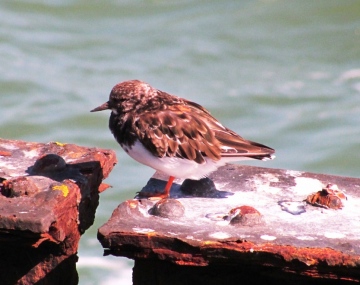
Eureka
Thanks to iSpot and David Noton, of the Natural History Museum, the mystery of the black fly and Garden Spiders, is to the best of my knowledge solved. The fly is a Free-booter Fly, Desmometopa m-nigra, given the name free-booter because of its habit of taking the body fluids of bees which have fallen prey to spiders. I have just watched 5 sitting on leaves near a web where a bee was being sedated and wrapped. Ants, Admirals, unknown flies and strange roves
With regard to ants we have had three flights recently, the latest this afternoon, accompanied by the usual black-headed gulls, but no starlings. They are absent from our area, have not seen any for ages. 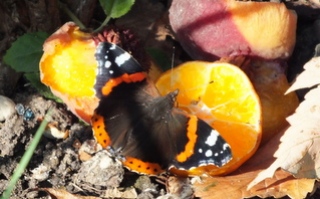 We have been graced by three Red Admirals over the last couple of days, the most seen this year. They were attracted to over ripe oranges cut in half. The local Bluebottles are being terrorised by them, much wing flashing being directed at them. Last month I posted an observation of flies on Garden Spider prey. The above is the lastest photo I was able to take, given the right light, of the spider flies. 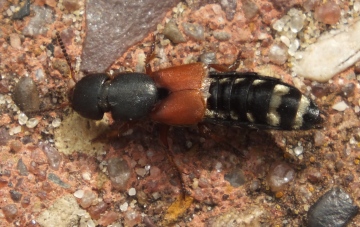 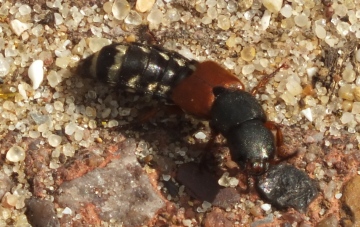 This Rove Beetle was taken on Dovercourt Promenade on 29/08/12. It was found finishing off the remains of a sand hopper. When approached it curled it's tail in the fashion of a Devils Coach Horse. Researched on the web it apppears it may Platydracus stercorius, and I would welcome advice on this one. Swan Mussel
Found this Swan Mussel shell at The Hyde Lake recently. It was one of a large number found in piles of mud dredged from the lake some time ago. It is exactly 20cm across, which is about as big as they get. The shell has growth rings and you can apparently age the mussel by counting these. If that is correct then this one was around 55 years of age when it was unceremoniously dumped on the bank - a sad end for a mollusc of such mature years.
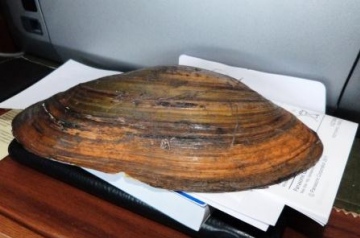
The fertilized eggs of this species apparently hatch inside the shell in winter and are nurtured until the following spring, when they are released. They trail a thread of sticky mucus from their 'tail' and with a bit of luck will eventually become attached to a passing fish. For the next few weeks they live a parasitic existence on their host but eventually drop off and begin an independent existence; like all mussels filtering algae and other micro organisms from the water.
About a year ago, at Blue House, we were visited by 83 year old George Agar, who for a couple of years in the 1930s lived at Hydemarsh Farm, which at that time was a separate property but is now part of the reserve. He told us how his father used to cut a beer barrel in half to make a boat and how he was expected to paddle this (somewhat unsteady) contraption across a nearby pond, known then as now as Cockle Pond, and dredge for 'cockles' with a bucket. It is a freshwater pond and from his description it would seem that Swan and Duck Mussels were the 'cockles' in question. As far as I know they are not considered edible nowadays but those were hardier times.
George also related a tale of how the Essex Hunt used to visit the farm on Saturdays during theFox hunting season and so he and his mate went round on the Friday evening shutting all the gates. This was not because they were budding hunt saboteurs but because the Master used to pay them at the end of the day for opening them! It was the Hunt tradition to tip assistants like George and his mate with a silver coin. The one they usually received was a silver threepenny bit, the lowest such denomination at that time, which led George to suggest that they were "mean ol' b-----s". But perhaps the Master was well aware of his (and his mate's) little ruse!
Mary - ants have been equally scarce in my garden. I have only seen one mass hatch of flying ants so far this summer, an emergence which quickly resulted in a flock of around 50 Black-headed Gulls and Starlings circling slowly overhead, picking off these hapless airborne treats one by one! Mind you, most days this summer it has been so windy that if they emerged at 2pm they would be in Upminster less than an hour later. I am impressed though that you have Blue Fleabane in the garden, I have only seen it twice - once near Holliwell Point, Dengie and on the other occasion at Roxwell, but perhaps it is still common in your neck of the woods. Anyway, one insect that has been common here of late is the Orange Swift, a male (above) and a female below.
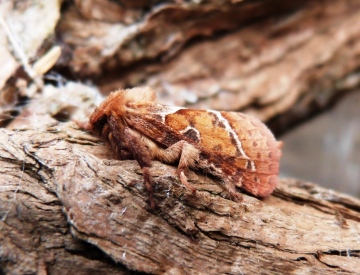
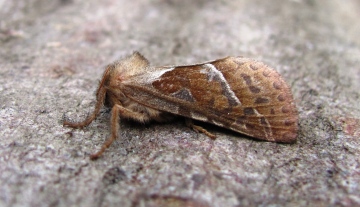
This species varies greatly in size and although the female is the far larger of the two pictured here this is not always the case and some individuals of both sexes are tiny - little bigger than your average wood Ant. |
|
Archives:
May 2020
Aug 2019
Jan 2019
Sep 2018
Jul 2016
Oct 2015
Jul 2015
May 2015
Apr 2015
Mar 2015
Feb 2015
Jan 2015
Dec 2014
Oct 2014
Sep 2014
Aug 2014
Jul 2014
May 2014
Apr 2014
Mar 2014
Feb 2014
Jan 2014
Dec 2013
Nov 2013
Sep 2013
Aug 2013
Jul 2013
Jun 2013
May 2013
Apr 2013
Mar 2013
Feb 2013
Jan 2013
Dec 2012
Nov 2012
Oct 2012
Sep 2012
Aug 2012
Jul 2012
Jun 2012
May 2012
Apr 2012
Mar 2012
Feb 2012
Jan 2012
Dec 2011
Nov 2011
Oct 2011
Sep 2011
Aug 2011
Jul 2011
Jun 2011
May 2011
Apr 2011
Mar 2011
Feb 2011
Jan 2011
Dec 2010
Nov 2010
Oct 2010
Sep 2010
Aug 2010
Jul 2010
Jun 2010
May 2010
Apr 2010
Mar 2010
Feb 2010
Nov 2009
Oct 2009
Aug 2009
Jul 2009
Jun 2009
May 2009
Apr 2009
Mar 2009
Feb 2009
Jan 2009
Nov 2008
Oct 2008
Sep 2008
Aug 2008
Jul 2008
Jun 2008
May 2008
Apr 2008
Mar 2008
Feb 2008
Jan 2008
Dec 2007
Nov 2007
current posts
|






























